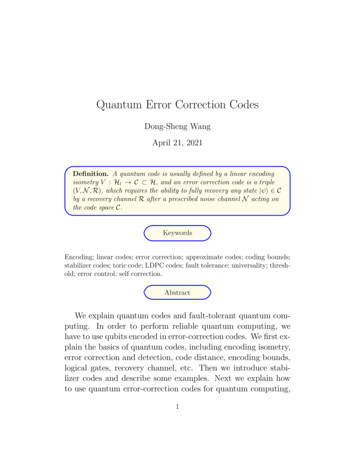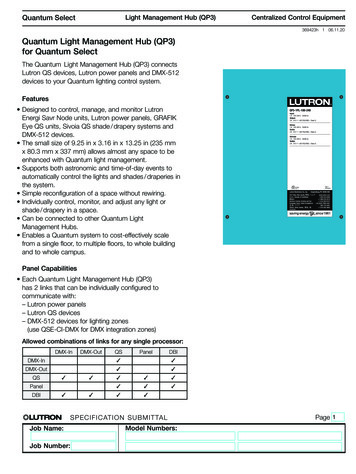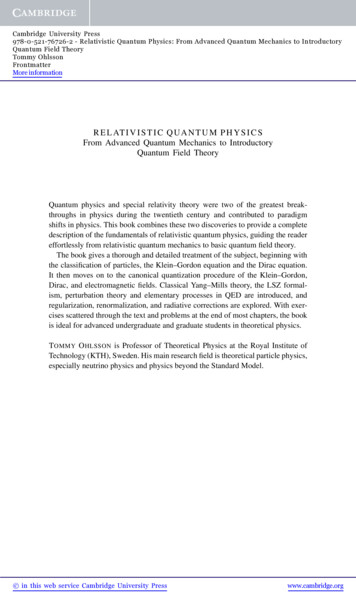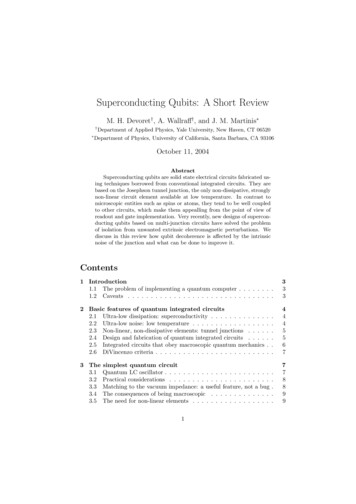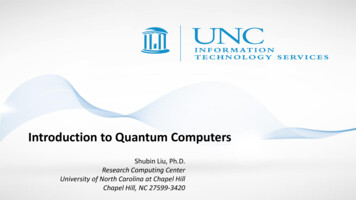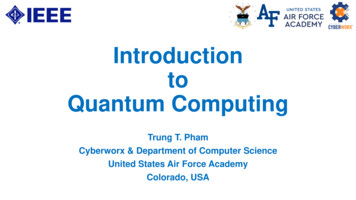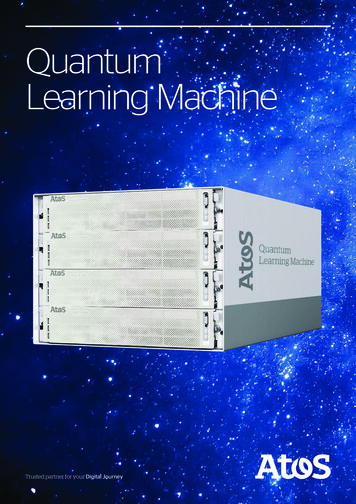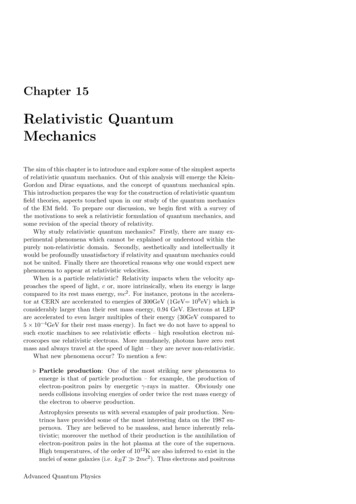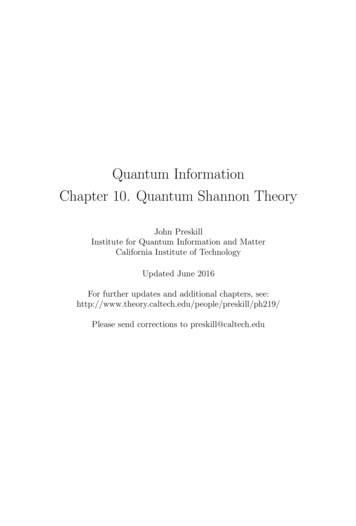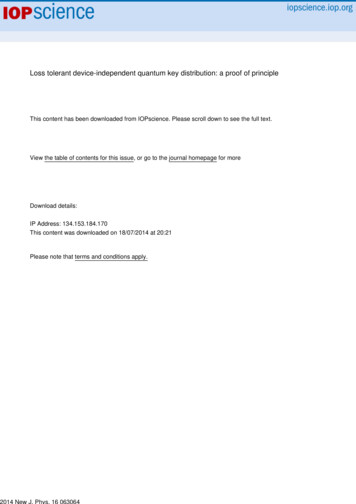
Transcription
HomeSearchCollectionsJournalsAboutContact usMy IOPscienceLoss tolerant device-independent quantum key distribution: a proof of principleThis content has been downloaded from IOPscience. Please scroll down to see the full text.2014 New J. Phys. 16 3064)View the table of contents for this issue, or go to the journal homepage for moreDownload details:IP Address: 134.153.184.170This content was downloaded on 18/07/2014 at 20:21Please note that terms and conditions apply.
Loss tolerant device-independent quantum keydistribution: a proof of principleGiuseppe Vallone, Alberto DallʼArche, Marco Tomasin and Paolo VilloresiDepartment of Information Engineering, University of Padova, I-35131 Padova, ItalyE-mail: vallone@dei.unipd.itReceived 18 January 2014, revised 25 April 2014Accepted for publication 16 May 2014Published 26 June 2014New Journal of Physics 16 (2014) 063064doi:10.1088/1367-2630/16/6/063064AbstractWe here present the rate analysis and a proof of principle demonstration of adevice-independent quantum key distribution protocol requiring the lowestdetection efficiency necessary to achieve a secure key compared to deviceindependent protocols known so far. The protocol is based on a non-maximallyentangled state and its experimental demonstration has been performed by twophoton bipartite entangled states. The improvement with respect to protocolsinvolving maximally entangled states has been estimated.Keywords: device independent quantum key distribution, Bell inequality, twophoton entanglement1. IntroductionQuantum key distribution (QKD) represents an unconditional secure way to share a secret keybetween two authenticated users, usually called Alice and Bob. Photons are the ideal candidatesfor QKD implementations due to their low interaction with the environment; moreover, theycan be easily transmitted over long distances with optical fibers [1–3] or free-space links [4–10].Security of the key is typically proven by using trusted preparation and measurement devices(for a review on QKD security and experimental implementations, see [11]). In the last years,great effort have been devoted to the so called device-independent QKD (DI-QKD), aiming atthe demonstration of the security when the measuring devices are completely untrusted andContent from this work may be used under the terms of the Creative Commons Attribution 3.0 licence.Any further distribution of this work must maintain attribution to the author(s) and the title of the work, journalcitation and DOI.New Journal of Physics 16 (2014) 0630641367-2630/14/063064 12 33.00 2014 IOP Publishing Ltd and Deutsche Physikalische Gesellschaft
G Vallone et alNew J. Phys. 16 (2014) 063064their working mechanism is not known to the users. The key ingredient for DI-QKD is theexploitation of entangled states shared between the two users: by violating a Bell inequality, it ispossible to prove the secrecy of the obtained key.The DI-QKD offers the advantage that security is independent of the practical details of theimplementation. Indeed, the violation of a Bell inequality certifies the secrecy of thetransmission, allowing Alice and Bob even to use devices directly provided by Eve. Theviolation of a Bell inequality without any additional assumption requires a very high globaldetection efficiency, from the source to the detectors. It is well known that non-maximallyentangled states offer an advantage, in terms of required detection efficiency, with respect tomaximally entangled states, to violate the Clauser–Horne–Shimony–Holt (CHSH) inequality[12, 13]. Recently, detection loophole-free violations of the CHSH inequality by nonmaximally entangled photons were indeed reported [14, 15]. Non-maximally entangled stateswere proven to be also useful for several bipartite Bell inequalities [16] and for quantumsteering [17].The ent-B92 protocol, a version of the B92 protocol [19] realized with non-maximallyentangled states, was proposed in [18]. We here propose its generalization and analyze its secretkey rate when detection inefficiencies are taken into account. We moreover present a proof-ofprinciple demonstration of the protocol by exploiting non-maximally entangled states producedby spontaneous parametric down conversion. By proof-of-principle we mean that wedemonstrate that it is in principle possible to realize the DI protocol with our experimentalgenerated state if higher detection efficiencies were used. Due to the efficiency of our setup(about 10%) it was not possible to achieve a complete DI-QKD realization. However, by usingequation (13) (see below), we will predict the experimental value of the Bell parameterachievable with our experimentally generated state in the case of a given efficiency η. By thisprediction we will estimate the achievable rate of our DI-QKD protocols.We will show that the protocols here presented allow a DI-QKD security with the lowestrequired threshold detection efficiency to date.2. Generalized ent-B92 protocolLet us consider Alice and Bob sharing the following non-maximally entangled state: Φ ( θ ) 〉AB cosθH2 〉 H〉AB sinθV2 〉 V〉AB,(1)where H and V are the horizontal and vertical polarization states and 0 θ π 2. Theparameter θ is monotonically related to the amount of entanglement, since the concurrence [20]is given by C sin θ .The protocol works as follow: Alice measures with low probability p 1 its photon alongthe 1 { a1 〉, a 1 〉 } basis, with a1 〉 V 〉 and a 1 〉 H 〉. With high probability 1 p shemeasures along the 0 { a0 〉, a 0 } basis, where a0 〉 12 ( H 〉 V 〉 ) and ā0 〉 is itsorthogonal state; Bob randomly and with probability 1 2 measures the incoming states in the 0or 1 basis where k { bk 〉, b k 〉 } and2
G Vallone et alNew J. Phys. 16 (2014) 063064φ H 〉 ( 1)k cos2φ b k 〉 cos H 〉 ( 1)k sin2bk sinφ V 〉 ,2φ V 〉 .2(2)The results from Aliceʼs 0 basis measurements are used as bits of the raw key together withBobʼs results, while those from the 1 basis will be used to perform a test against theeavesdropper attack, as in the uninformative states B92 QKD protocol (us-B92) introduced in[21]. On Alice’s side, the states a0 and ā0 correspond to bits 0 and 1 respectively. Uponobtaining the state bk Bob decodes Aliceʼs bit as j k 1 (the symbol means ‘additionmodulo 2’) and labels the result as conclusive; on the contrary, upon obtaining the state b̄k ,Bob labels the result as inconclusive. The probability of a conclusive event is given byPc 12 ( 1 cos θ cos φ ), independent of Alice measurements. The sifted key is obtained byselecting the conclusive results corresponding to Aliceʼs 0 measurements. The ent-B92protocol of [18] corresponds to the choice φ θ .The main problem of a fully DI-QKD protocol is related to the so called detectionloophole, namely the fact that the photon detection is inefficient and, if the detectors are nottrusted, an eavesdropper can exploit this inefficiency to gain information on the key. In the nextsection we will show how to extract a secure key in the device-independent scenario in thepresence of detection (and transmission) inefficiencies.3. Key rate analysisIn this section we will derive the secret key rate (see equation (9)) of the generalized ent-B92protocol in the case of detection inefficiencies, improving the results obtained in [18].Let us consider a transmission of pairs in which Alice chooses the 0 basis and Bobchooses with probability 12 the basis 0 or 1. The 1 outputs of Aliceʼs measurementscorrespond to bits 1 and 0 of the sifted key. The overall efficiencies (including transmission anddetection efficiencies) are given by ηA and ηB and Alice and Bob must decide a strategy to dealwith non-detection events. On Bobʼs side, only 1 outputs, the so called conclusive outcomes,are taken into account to build the key: thus, on Bob side, a non-detection event will beassociated with 1 output (corresponding to non-conclusive outcomes). Then, all Aliceʼs bitscorresponding to non-conclusive Bob outcomes can be simply discarded, as is usually done inthe sifting phase of the BB84 protocol. On the other side, when Alice measures in the 0 basisand does not obtain physical detection, she randomly chooses an outcome: whatever value shedecides to output, the bit will enter into the key. Alice thus assigns to non-detection events the a0 〉 or ā0 〉 outcome with 1 2 probability in this case.Due to inefficiencies, Bob receives Pc ηB conclusive counts. After the sifting phase,Alice’s string Ac and Bobʼs string Bc consist of Pc ηB bits. In [18] (see in particularequation (11) and (12)), the secure key rate—the ratio between secure bits and the overall sentpairs—is given in term of the quantum bit error rate (QBER) Q c and the Clauser–Horne (CH)parameter SCH P (a1, b1 ) P (a0 , b1 ) P (a1, b0 ) P (a0 , b0 ) P (a1 ) P (b1 ) [12] as3
G Vallone et alNew J. Phys. 16 (2014) 063064r ηA ηB Pc 1 h 2 Q c log 2 f SCH ,( )( )(3)where( )21 4SCH 4SCH.f SCH 1 (4)and h 2( x ) is the binary entropy given by h 2(x ) x log2 x (1 x ) log2(1 x ). The rate isderived under the assumption that the measurement devices are memoryless. In the previousexpression P(ai , bj ) is the joint probability that Alice measures the state ai 〉 and Bob detects thestate bi 〉, while P(a1 ) and P(b1 ) are the probabilities that Alice and Bob respectively measure a1 〉 and b1 〉, regardless of what is measured by the other user. The QBER Q c , defined as theratio of the number of errors over the number of conclusive outcomes, must be evaluated overthe sifted strings Ac and Bc .By using a technique introduced in [22], Alice and Bob can improve the secure key rate:they will perform a post-selection on Ac and Bc , by selecting only the bits in which also Aliceobtained a physical detection. We called Aps and Bps the post-selected Aliceʼs and Bobʼs strings,with length Pc ηA ηB .The length of the secure key can be bounded by [23]( )( )ℓ Hmin Bps E Hmax Bps Aps ,(5)( )( B A ) P η η h ( Q ) is related to the classical error correction protocol between thewhere Hmin Bps E is the min-entropy of Bps conditioned on Eveʼs information. As usual,Hmaxpspspsc B A2Aps and Bps strings. In the previous expression Q ps is the QBER on the post-selected data, and,its theoretical value Qthps in the case of no channel or measurement errors, is given by :Qthps 1 cos ( θ φ)2 2 cos θ cos φ.(6)The choice φ θ , used in the ent-B92 protocol, gives null QBER. We will see that this choicedoes not always represent the optimal choice for the secure key rate.As demonstrated in [22], by using the chain rule and the data-processing inequality forsmooth min-entropy [24, 23], it is possible to bound Eveʼs information on the sifted bits byusing her information on Bc :()()()Hmin Bps E Hmin Bc E Pc ηB 1 ηA ,((7))where Pc ηB 1 ηA is the difference between the Bc and the Bps string length.As shown in [25], the min-entropy can be related to the maximal probability of guessingthe key bits, namely()()Hmin Bc E Pc ηB log 2 Pguess Bc E .(8)By using the results of [26], the probability of guessing the bits can be related to the Bell(f (S))inequality by Pguess Bc E 2CH . The final secure key length can be thus written asℓ Pc ηB ηA 1 h 2( Q ps ) log2 f ( SCH ) and the final rate r ℓ becomes()4
G Vallone et alNew J. Phys. 16 (2014) 063064Figure 1. Theoretical secure key rate r for the generalized ent-B92 protocol, in the caseof perfect detection efficiencies.r ηB Pc ηA ( 1 h 2( Q ps ) ) log 2 f ( SCH ) .(9)As usual, in the secure rate formula, the h 2( Q ps ) term corresponds to the bits used for errorcorrection, while the log2 contribution is related to Eveʼs knowledge of the key and the requiredcompression in the privacy amplification stage. The violation of the CH inequality SCH 0 [12]is a test against the local-realism of quantum physics: it can be trivially checked that, when theinequality is not violated, the secure rate (9) is zero2.In the case of perfect efficiencies, the theoretical value of SCH for the non-maximallyentangled state (1) and the measurement defined in (2) is given bySCH( θ , φ ) 12 ( cos φ sin θ sin φ 1). The choice φ arctan ( sin θ ) leads to the maximummaxachievable violation with the state (1), namely SCH(θ) 12()sin2θ 1 1 . It is worthnoting that considering a trusted measurement device is equivalent to taking perfect efficiencies,namely ηA 1 and/or ηB 1. In fact, if the device is trusted, we can safely consider only thedetected events. In this way, we can have three possible scenarios: full DI-QKD when the actualefficiencies are considered, one-side device independent-QKD (1SDI-QKD) [22] in which onlyone of the two devices (Alice or Bob) is trusted, and standard QKD with both trusted devices. Inthe case of standard QKD (corresponding to ηA ηB 1), the achievable rate with the ent-B92protocol (corresponding to φ θ ), is shown in figure 1 with the maximum rate obtained forθ 65.28 . By using the angle that maximizes the violation of the Bell inequalityφ arctan ( sin θ ) it is possible to improve the rate when θ 71.62 (see figure 1). More()generally, it is possible to numerically optimize the value of the parameter φ φ ( θ ) as afunction of θ to maximize the achievable rate, as shown with the dashed line in figure 1. Notethat, whenever φ θ , the theoretical QBER is not vanishing: however, the non-vanishingQBER can be compensated by a larger violation of the CH inequality, allowing more secrecy inthe privacy amplification stage. It is clear that, when Alice and Bob have trusted devices(corresponding to the fair sampling assumption of non-locality tests), the ent-B92 protocolcannot offer advantages with respect to the entangled version of the BB84 protocol [27, 26]. Infact, in this case, the secure key rate of ent-B92 is always lower than the BB84, given byrBB84 1 2h 2( Q ). As we will see, the advantages come when one (or both) device is nottrusted: in this case, the lower threshold detection required by the (generalized) ent-B922If the key rate r obtained in (9) is negative, no secure key can be distilled.5
G Vallone et alNew J. Phys. 16 (2014) 063064protocol to violate the CH inequality, gives considerable improvement of the secure key ratewith respect to protocols based on maximally entangled states.The rate achieved in (9) on the post-selected data can be compared to the one obtainedwithout post-selection (3), with QBER Q c evaluated over all conclusive events. Since Aliceassigns to non-detection events the a1 or ā1 outcomes with 1 2 probability, in this case theQBER of the sifted key will beQ c ηA Q ps 1 ηA2.(10)It is easy to show that the rate r̃ (3) is lower than the rate r (9) achievable with the post-selectiontechnique for any ηA 1 while r r when ηA 1.It is also useful to compare the result obtained in (9) to the one obtained with the postselection technique in [22] using the usual DI-QKD protocol of [26] implemented withmaximally entangled states (the entangled version of the BB84 protocol):(( )) log f (S ).r′ ηA ηB 1 h 2 Q ps2CH(11)The difference between r and r′ arises from the fact that in the BB84 protocol thekey is obtained by using the results of Bob in a single basis, while in thegeneralized ent-B92 protocol the key is obtained by keeping Bobʼs conclusive results inthe basis 0 and 1.4. Proof of principle demonstrationIn this section we present a proof of principle demonstration of the protocols above described.As anticipated in the introduction, we will not present a complete DI-QKD realization due to thelow detection efficiencies measured in our setup. By generating a two-photon non-maximallyentangled state by spontaneous parametric down conversion, we will demonstrate that it is inprinciple possible to realize the DI protocol with our experimental generated state if higherdetection efficiencies were used. We first describe the results obtained in a trusted scenario(standard QKD) in order to test our entanglement source and then analyze what can be achievedin a DI framework.Our source of non-maximally entangled states, shown in figure 2, is given by twooverlapped type-I nonlinear BBO crystals illuminated by a pulsed UV laser at 405 nm . The twospontaneous parametric down-converted photons are emitted at 810 nm . The two crystals haveoptical axes rotated by 90 : the first crystal generates the HH pairs, while the second crystalgenerates the VV pairs. By using a pump laser with polarization cos θ2 V p sin θ2 H p the nonmaximally entangled state (1) can be generated. By varying the linear polarization on the pumplaser it is possible to change the relative contribution of the HH and VV terms in thegenerated state. The UV laser has pulse duration of about 10 ps and 76 MHz repetition rate. Dueto the long coherence time of the pump laser, it is not necessary to compensate the temporalwalk-off in the BBO crystals. We note that, by this protocol, Bob does not need to project intothe bk states, since they do not appear in the CH inequality nor are used in the sifted keygeneration. Bob’s measurements can be thus restricted to the positive-operator valued measure6
G Vallone et alNew J. Phys. 16 (2014) 063064Figure 2. Top: scheme of the generalized ent-B92 scheme. Bottom: experimental setupused for the generation of the non-maximally entangled state and the demonstration ofthe protocol.Figure 3. Left: experimental value of the parameter SCH and corresponding errors for theent-B92 (blue circles) and the φ arctan ( sin θ ) protocol (red stars). Right:experimental key rates for the two protocols with trusted measurement devices.Continuous and dashed lines refer to theoretical predictions corresponding to perfectstate generation and noise model (12) respectively.(POVM) Π0 12 b0 〉〈b0 , Π1 12 b1 〈b1 and Πinconc Π0 Π1. From the experimentalpoint of view Bobʼs measurement can be simply represented by a beam splitter and twopolarizers.As said, we tested our source by measuring the Bell parameter SCH and the achievablesecure key rate in the case of trusted measurement devices. In figure 3 we show theexperimental value of SCH and the secure key rate r as a function of the entanglement parameterθ. If the obtained rate r is below zero, no secure key can be extracted. In order to take intoaccount imperfections in the setup, the experimental generated state can be expressed by thefollowing noise model: ρexp 1 pc pw Φ θΦ ( θ ) pc ρc pw .(12)4() ( ) 〉〈 In the previous equation the state ρc is given by ρc cos2( θ2 ) HH 〉〈HH sin2( θ2 ) VV 〉 VV and pc ( pw ) represents the amount of colored (white) noise. The dashed line in figure 3 represents7
G Vallone et alNew J. Phys. 16 (2014) 063064the theoretical value of the SCH parameter and the secure rate r obtained by the state (12) withpw 0.007 and pc 0.015, with good agreement between the model and the obtained results.To further validate our noise model we present in appendix B its prediction for the thresholddetection efficiencies required for the violation of the Bell inequality.Let us now analyze what can be achieved in a DI framework. We calculated the overalldetection efficiency of our system by evaluating the ratio between the measured coincidencesand the single counts, thus taking into account transmission, coupling into fibers and detectionlosses. Since the measured detection efficiency is about 10% for both Alice and Bob we cannotachieve DI secure key rate. Nevertheless, we can estimate the key rate achievable with givendetection efficiencies ηA and ηB . Indeed, by assuming that probabilities P (ai , bj ) are related tothe probabilities p (ai bj ) normalized on the post-selected events in which Alice and Bob have acoincidence, we can predict the CH parameter as (see appendix A for its derivation): 1111SCH ηA ηB p ( a1 b1 ) p ( a 0 b1 ) p ( a1 b0 ) p ( a 0 b0 ) p ( a 0 b0 ) p ( a 0 b1 ) 2222η ηA p ( a1 b0 ) p ( a1 b 0 ) B p ( a 0 b1 ) p ( a 0 b1 ) p ( a 0 b0 ) p ( a 0 b0 ) 2 (13)The previous expression can be derived under the condition that on the 1, 0 and 1 basis,non-detection events are associated with 1 outputs, namely with the states ā1 , b̄0 and b̄1 ,while the states a0 and ā0 are randomly chosen in the case of non-detection in the 0 basis.Then, by measuring the probabilities appearing in equation (13), we can estimate the valueof the Bell parameter in the case of arbitrary efficiencies ηA and ηB and thus predict the securekey rate achievable with our experiment states when more efficient detectors are used. It isworth noticing that overall efficiencies of the order of 75% were already demonstrated in the labby using superconducting TES detectors in [14, 15].Let us first consider full DI-QKD with Alice and Bob having the same efficiencyηA ηB η. For each value of η is possible to optimize the value of θ (or θ and φ) thatmaximizes the key rate for the ent-B92 (or generalized ent-B92) protocol: in figure 4(left) weillustrate the achievable key rate as a function of the detection efficiency for the ent-B92 and thegeneralized protocol. We note that positive secure key rate can be obtained up to an efficiencyof 90.57%, improving the results of 90.9% and 91.1% obtained respectively in [28] and [22].We also show the rates that can be achieved with our experimental generated state. In particular,we indicate with dashed lines the predicted rates achievable by using the theoretical noisy stateof equation (12) to calculate the probabilities appearing in equation (13). With green squares wereport the rates achievable when the probabilities that we have experimentally measured areused to evaluate equation (13). Such rates are below the rates achievable with a perfect nonmaximally entangled state Φ (θ ) 〉 due to the presence of decoherence and white noise causinga decrease of the state purity. Our measurements indicate that it is necessary to generate stateswith high purity in order to reach low detection efficiencies.Great improvement with respect to state-of-the-art results is obtained by considering oneside DI-QKD in which Aliceʼs device is trusted, corresponding to ηA 1 in the secure key rate(9) and in the predicted Bell parameter (13). In this case, the rate r corresponds to the fraction ofsecure bits over Aliceʼs detected bits. In figure 4 (right), we show the achievable key rate as a8
G Vallone et alNew J. Phys. 16 (2014) 063064Figure 4. Key rates achievable for (left) the full DI-QKD case (ηA ηB η) and for(right) the 1SDI-QKD (ηA 1) as a function of the detection efficiency. For 1SDI-QKDthe rate is the number of secure bits over the bits detected by Alice. With continuouslines we indicate the theoretical rates achievable with the non-maximally entangled stateΦ ( θ ) . With dashed lines we indicate the predicted rates obtained by using the noisemodel of equation (12), while with green squares we indicate the rates achievable whenthe experimentally measured probabilities are used to evaluate equation (13).function of the detection efficiency in the one-side DI-QKD case. For the ent-B92 protocol, thesecure key rate (without experimental imperfection) becomes r ηB Pc [1 log2 f (SCH ) ], whichis positive whenever the Bell inequality SCH 0 is violated. Note that the same rate can beobtained by the original analysis of the ent-B92 protocol [18] applied for the one-side case. Weremark that it is possible to obtain positive secure key rate up to a detection efficiency of 50%,improving the result obtained in [22] in which an efficiency greater than 65.9% is required forkey generation. Also in this case we show the rate predicted by our experimental data: thesedata show again that, in order to fully exploit the properties of low entangled states, it isnecessary to generate quantum states with low noise.Our result closes the gap, from the theoretical point of view, between one-side Bellinequality (also known as steering inequality [29, 30, 22]) and key generation in 1SDI-QKD,since in our protocol the violation of the Bell inequality corresponds to a positive secure keyrate. For fully DI-QKD there still remains a gap, which is due to the difference between thethreshold of η 82.8% needed for a violation of the CHSH inequality [13] and the efficiencyrequired for the security of DI-QKD, namely η 90.57%.5. ConclusionsWe have derived an efficient key rate for the (generalized) ent-B92 protocol in the case ofdetection inefficiencies. We experimentally tested our result with two-photon non-maximallyentangled states with good agreement between theory and experiment. The protocol is able toachieve a secure key rate with the lowest detection efficiency to date. While the improvementfor the full DI-QKD case is small and has mainly theoretical relevance (we lowered thethreshold efficiency from 90.9% to 90.57%), great improvement is obtained in the one-side DIQKD: it is possible to achieve positive secure key rate up to 50% efficiency, to be comparedwith the state of the art result of 65.9% [22].9
G Vallone et alNew J. Phys. 16 (2014) 063064AcknowledgmentsThe authors would like to thank Professor P Mataloni from the University Sapienza of Roma(IT), Dr G Di Giuseppe from University of Camerino (IT) and Dr M Lucamarini from ToshibaResearch Europe Ltd (UK) for useful and stimulating discussions. Our work was supported bythe Strategic-Research-Project QUANTUMFUTURE (STPD08ZXSJ) of the University ofPadova and Strategic-Research-Project QUINTET of the Department of InformationEngineering, University of Padova.Appendix A. Predicted Bell parameter in the case of detection inefficienciesLet us consider the CH parameter( )SCH P ( a1, b1 ) P ( a 0 , b1 ) P ( a1, b0 ) P ( a 0 , b0 ) P a1 P ( b1 ),(A.1)with the probabilities P normalized over all generated pairs. In the case of detectioninefficiencies ηA and ηB we can predict the values of each probability. In the generalized ent-B92protocol, non-detection events are associated with the states ā1 〉, b̄0 〉 and b̄1 〉 whenthe observables 1, 0 and 1 are respectively measured. Then, the probabilities P can bepredicted asP ( a1, b1 ) ηA ηB p ( a1 b1 ), P ( a1 ) ηA p ( a1 ) ηA p ( a1 b0 ) p ( a1 b 0 ) ,P ( a , b ) η η p ( a b ), P ( b ) η p ( b ) η p ( a b ) p ( a b ) , (A.2)10A B1 01B1B0 10 1where p (ai bj ) are the probabilities normalized on the post-selected events in which Alice andBob have a coincidence.On the other hand, when measuring the 0 observable, it is necessary to remember that, inthe case of non-detection, the state a0 〉 is chosen with probability 12 . Then1P ( a 0 , b0 ) ηA ηB p ( a 0 b0 ) 1 ηA ηB p ( b0 )2 1 ηA ηB p ( a 0 b0 ) 1 ηA ηB p ( a 0 b0 ) p ( a 0 b0 ) , 2 1P ( a 0 , b1 ) ηA ηB p ( a 0 b1 ) 1 ηA ηB p ( b1 )2 1 ηA ηB p ( a 0 b1 ) 1 ηA ηB p ( a 0 b1 ) p ( a 0 b1 ) .(A.3) 2 By inserting equations SCH ηA ηB p ( a1 b1 ) ηA p ( a1 b0 ) ()()()()(A.2) and (A.3) into (A.1) we obtained the predicted Bell parameter as 1111p ( a 0 b1 ) p ( a1 b0 ) p ( a 0 b0 ) p ( a 0 b0 ) p ( a 0 b1 ) 2222η p ( a1 b 0 ) B p ( a 0 b1 ) p ( a 0 b1 ) p ( a 0 b0 ) p ( a 0 b0 ) .(A.4) 2 10
G Vallone et alNew J. Phys. 16 (2014) 063064Figure B1. Threshold detection efficiencies needed for the violation of the Bellinequality in the ηA ηB η case (left) and in the ηA 1 case (right). Continuous anddashed lines respectively represent theoretical values obtained in the case of noimperfection and by using the noise model of equation (B.1). We also report thethreshold achievable with a perfect maximally entangled state (MES).Appendix B. Error model verificationAs written in the main text, we used a noise model in order to take into account the possiblenoise sources in our setup. The noise model takes into account two possible sources: the first isdue to the effect of background photons, modeled by the addition of a white noise 4 andcorresponding to a depolarizing channel. The second is due to partial distinguishability of the HH 〉 and VV 〉 events generated by the two SPDC crystals causing partial decoherence: thiseffect is modeled by a colored noise ρc , corresponding to a phase damping channel [31].Therefore, the generated state can be expressed by the following model: (B.1)ρexp 1 pc pw Φ ( θ ) Φ ( θ ) pc ρc pw .4()In the previous equation ρc cos2( θ2 ) HH HH sin2( θ2 ) VV VV and pc ( pw ) represents theamount of colored (white) noise. To further validate our noise model we checked thepredictions of our model with the experimental data for the threshold detection efficiencies.Let us consider the case ηA ηB η th . From equation (6) of the main text, the thresholddetection efficiency required to violate the Bell inequality can be predicted to bep ( a1 b0 ) p ( a1 b 0 ) 12 p ( a 0 b1 ) 12 p ( a 0 b1 ) 12 p ( a 0 b0 ) 12 p ( a 0 b0 ).(B.2)ηth p ( a1 b1 ) 12 p ( a 0 b1 ) p ( a1 b0 ) 12 p ( a 0 b0 ) 12 p ( a 0 b0 ) 12 p ( a 0 b1 )If ηA 1 (corresponding to Aliceʼs device trusted), Bobʼs threshold detection efficiency being,ηB , can be predicted to bep ( a1 b0 ) p ( a1 b 0 )(B.3)ηBth p ( a1 b1 ) p ( a1 b0 ) p ( a 0 b0 ) p ( a 0 b1 )11
G Vallone et alNew J. Phys. 16 (2014) 063064In figure B1 we show the theoretical prediction and the experimental values of η th and ηBth .Continuous lines represent theoretical prediction without imperfection, while dashed linescorrespond to the prediction of the model (B.1) with pw 0.007 and pc 0.015. Also in thiscase, we have good agreement between the model and the obtained results. As the modelpredicts, when white noise is turned on, states with very low entanglement cannot offeradvantages with respect to states with larger entanglement. In order to full
Download details: IP Address: 134.153.184.170 This content was downloaded on 18/07/2014 at 20:21 Please note that terms and conditions apply. Loss tolerant device-independent quantum key distribution: a proof of principle View the table of contents for this issue, or go to the journal homepage for more
